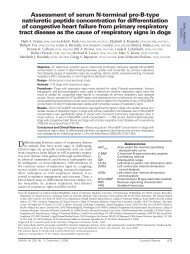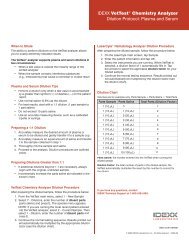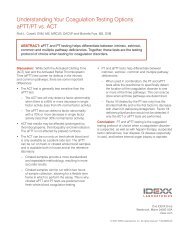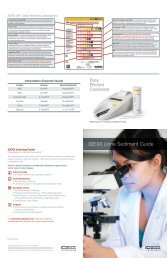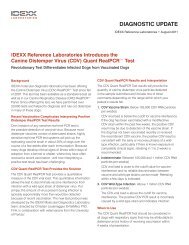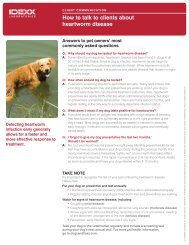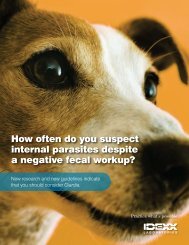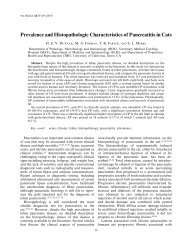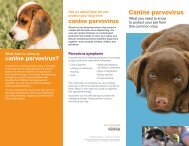Feline Heartworm Disease Roundtable - IDEXX - IDEXX Laboratories
Feline Heartworm Disease Roundtable - IDEXX - IDEXX Laboratories
Feline Heartworm Disease Roundtable - IDEXX - IDEXX Laboratories
Create successful ePaper yourself
Turn your PDF publications into a flip-book with our unique Google optimized e-Paper software.
Supplement to Compendium:<br />
Continuing Education for Veterinarians<br />
Vol. 30, No. 8(A) • August 2008<br />
A <strong>Roundtable</strong> Discussion<br />
FELINE<br />
HEARTWORM<br />
DISEASE<br />
Understanding the Role of <strong>Heartworm</strong> Infection<br />
in Respiratory <strong>Disease</strong> in Cats<br />
Sponsored by <strong>IDEXX</strong> <strong>Laboratories</strong> and Pfizer Animal Health
If you’re not seeing feline heartworm disease, you may be looking in the wrong<br />
place. <strong>Feline</strong> heartworm disease does exist and is a potentially life-threatening<br />
infection. It causes more problems than ever thought possible, presents numerous<br />
diagnostic challenges, and is very different from the canine disease. In light of recent<br />
research, emerging data, and the anticipated launch of the new SNAP® <strong>Feline</strong> Triple<br />
Test, several veterinary experts met to discuss the serious threat of heartwormassociated<br />
respiratory disease (HARD), the pros and cons of the various testing<br />
methods, and the importance of heartworm prevention in cats.<br />
<strong>Feline</strong> <strong>Heartworm</strong> FAQ<br />
<strong>Heartworm</strong> disease is rare in cats, so why should I<br />
be concerned about it<br />
<strong>Feline</strong> heartworm disease is more prevalent<br />
than we once thought. Studies have shown<br />
that feline heartworm infection rates likely<br />
meet or surpass infection rates for feline<br />
leukemia. Additionally, other data have<br />
suggested that the feline adult heartworm<br />
infection rate can be estimated to be 20%<br />
of the canine infection rate for the same<br />
geographic area. Although prevalence studies<br />
are ongoing, current research suggests that<br />
more cats are at risk than previously thought.<br />
What is HARD<br />
<strong>Heartworm</strong>-associated respiratory disease,<br />
or HARD, refers to the presentation and<br />
clinical circumstances associated with<br />
the death of immature adult heartworms<br />
(so-called fifth-stage larvae) or the presence<br />
of adult worms in the pulmonary arteries<br />
of heartworm-infected cats.<br />
Is feline heartworm disease really that dangerous<br />
<strong>Feline</strong> heartworm disease is potentially<br />
more dangerous than its canine counterpart<br />
for two critical reasons. First, diagnosis<br />
is complicated and findings can be<br />
inconsistent. A heartworm-infected cat<br />
may present with severe respiratory signs<br />
but test negative on antigen and antibody<br />
tests. Ancillary tests such as thoracic<br />
radiography, serum chemistry analysis, and<br />
echocardiography can also be inconclusive.<br />
Cats can also die suddenly with no evidence<br />
of preexisting illness.<br />
Second, there is no approved treatment for<br />
feline heartworm disease, so the only way<br />
to protect feline patients is to initiate yearround<br />
heartworm prevention early in life.<br />
All cats, even “indoor cats,” should be on<br />
prevention.<br />
What is the best way to diagnose heartworm<br />
disease in a cat<br />
Diagnosis of feline heartworm disease can<br />
be a complicated and costly procedure.<br />
<strong>Heartworm</strong> antigen and antibody tests<br />
have been recommended as the initial<br />
diagnostic steps. Refer to the algorithm and<br />
supporting text on pages 8 and 9 for a more<br />
detailed discussion of diagnostic options.<br />
If heartworm test results are inconsistent,<br />
why recommend testing to clients<br />
<strong>Heartworm</strong> testing should be<br />
considered in many cats, including<br />
newly acquired cats, sick cats<br />
(especially those presenting with<br />
respiratory signs), and healthy cats<br />
that are going to receive heartworm<br />
preventive. Although test results in<br />
general can be inconclusive, the<br />
SNAP® <strong>Feline</strong> Triple Test will soon<br />
be available to screen feline patients<br />
for heartworm disease. Veterinarians<br />
and clients need to understand that<br />
heartworm disease poses a serious<br />
threat to cats. Testing will detect<br />
infection in a significant number of<br />
cats and therefore plays an important<br />
role in identifying at-risk patients<br />
and increasing veterinarians’ and<br />
clients’ understanding of local disease<br />
prevalence.<br />
How can I convince clients to put cats,<br />
especially indoor cats, on heartworm<br />
preventive<br />
<strong>Feline</strong> heartworm disease is an<br />
incurable and potentially fatal disease.<br />
Outdoor cats are certainly at risk, but<br />
mosquitoes can get indoors and expose<br />
indoor cats to this threat as well. In<br />
a recent study, 27% of heartworminfected<br />
cats were exclusively indoor<br />
pets according to their owners. 1 As<br />
veterinarians educate clients about<br />
protecting their indoor cats from fleas<br />
and intestinal parasites, heartworms<br />
need to be included among the<br />
parasites that continue to pose a<br />
danger to indoor cats. As mentioned,<br />
there is no approved treatment for<br />
feline heartworm disease, but it is<br />
readily preventable.<br />
About the Participants<br />
Lynn Buzhardt, DVM, Moderator, a 1980 graduate of<br />
Louisiana State University School of Veterinary Medicine, is<br />
a companion animal practitioner and partner in The Animal<br />
Center in Zachary, Louisiana. She serves on the East Baton<br />
Rouge Parish Animal Control Committee, is a board member of<br />
the American <strong>Heartworm</strong> Society, conducts FDA clinical trials,<br />
and is a spokesperson for several animal health companies.<br />
Her book, Can We Have One: A Parent’s Guide to Raising<br />
Kids, Cats, and Dogs, will be available in fall 2008.<br />
Byron L. Blagburn, MS, PhD, holds the appointment of<br />
distinguished university professor at the Auburn University<br />
College of Veterinary Medicine. He is past president of<br />
the American Association of Veterinary Parasitologists,<br />
the Southern Conference on Animal Parasites, and the<br />
Southeastern Society of Parasitologists. Dr. Blagburn was<br />
the 2001 recipient of the American Association of Veterinary<br />
Parasitologists’ Distinguished Veterinary Parasitologist Award<br />
and the 2003 recipient of the Auburn University Student<br />
Government Association Teacher of the Year award.<br />
Mark Cousins, DVM, DABVP (<strong>Feline</strong>), graduated from<br />
Louisiana State University in 1980 and AAHA’s Veterinary<br />
Management Institute at Purdue University in 1995. He<br />
started and owns New Orleans’ first exclusively feline<br />
practice, The Cat Practice, in 1987 and is a partner in<br />
Chateau Veterinary Hospital in Kenner, Louisiana. The Cat<br />
Practice has won several awards, most notably the Hospital<br />
of Merit Award in the September 2005 issue of Veterinary<br />
Economics and the Innovation in Business Award from the<br />
New Orleans Chamber of Commerce.<br />
Ray Dillon, DVM, MS, MBA, DACVIM, received his<br />
DVM from Texas A&M University in 1973. He was the first<br />
recipient and continues to hold the Jack O. Rash Chair in<br />
Medicine at Auburn University. Dr. Dillon is the recipient<br />
of numerous awards, including the Phi Kappa Phi Scholar<br />
for Auburn University, Exceptional Achievement in Auburn<br />
University Outreach, and the Beecham Award for Research<br />
Excellence, and was the founding president of the American<br />
College of Veterinary Internal Medicine Foundation.<br />
Julie K. Levy, DVM, PhD, DACVIM, graduated from the<br />
School of Veterinary Medicine at the University of California,<br />
Davis, and earned her PhD in the immunopathogenesis<br />
of FIV infection at North Carolina State University. She is<br />
currently assigned to the small animal internal medicine<br />
service at the University of Florida. Her research and clinical<br />
interests center on feline infectious diseases, neonatal kitten<br />
health, and humane alternatives for feline population control.<br />
Tom Nelson, DVM, is the immediate past president of<br />
the American <strong>Heartworm</strong> Society. He earned his degree at<br />
Texas A&M University and has been in private practice for<br />
29 years. He is a partner, surgical director, and co–medical<br />
director at the Animal Medical Center of Northeast<br />
Alabama in Anniston. Dr. Nelson was awarded the 2002<br />
Public Relations award by the Texas Veterinary Medical<br />
Association and is a board member of the Companion Animal<br />
Parasite Council.<br />
2 <strong>Feline</strong> <strong>Heartworm</strong> <strong>Disease</strong> Supplement to Compendium • Vol. 30, No. 8(A) • August 2008 3
Estimating the Prevalence of <strong>Feline</strong><br />
<strong>Heartworm</strong> Infection<br />
Dr. Lynn Buzhardt: Let’s begin by illustrating<br />
the significance of feline heartworm disease.<br />
Dr. Levy, please review the information gathered<br />
from your work with shelter cats in Florida.<br />
Dr. Julie Levy: My journey with feline heartworm<br />
disease started when an apparently healthy feral<br />
cat died under anesthesia for neutering. A<br />
Levy: It appears that the risk for infection<br />
with adult heartworms is equivalent to the<br />
risk for the retroviral infections, but the risk<br />
for infection with immature heartworms,<br />
which we now know cause disease, is three<br />
times as high as the retroviral diseases.<br />
necropsy revealed a single adult heartworm<br />
in the pulmonary artery, which led to a debate<br />
among my colleagues about whether we should<br />
be recommending heartworm preventives for all<br />
of our feline patients. Was this a freak finding or a<br />
significant threat to our patients<br />
To answer the question about the risk<br />
in our Gainesville, Florida, community,<br />
we necropsied hundreds of cats after they<br />
were euthanized at the local animal control<br />
facility. We were startled to find that 5%<br />
of cats had adult heartworms, which was<br />
similar to the rate of feline leukemia virus<br />
(FeLV) and feline immunodeficiency virus<br />
(FIV) infection in the same group of<br />
cats. We were even more surprised<br />
to find that about 15% of the cats<br />
were seropositive for heartworm<br />
antibodies and that these cats suffered<br />
substantial lung disease even if there<br />
were no adult worms.<br />
Based on the new data, we now know<br />
that the risk for heartworm infection<br />
is even greater than the risk for these<br />
retroviral diseases we’ve been testing for and<br />
vaccinating against. We were beginning to<br />
feel like our traditional approach to diagnosis<br />
of heartworm disease in cats was detecting only<br />
the tip of the iceberg.<br />
Buzhardt: Let’s talk about actual prevalence<br />
in relation to antigenicity. Based on data from<br />
<strong>IDEXX</strong> Reference Laboratory submissions, 1%<br />
Relative Risk of Various <strong>Feline</strong> <strong>Disease</strong>s<br />
16%<br />
12%<br />
8%<br />
4%<br />
0%<br />
<strong>Heartworm</strong><br />
(antigen 2 )<br />
<strong>Heartworm</strong><br />
(antibody 3 )<br />
Lower Urinary<br />
Tract <strong>Disease</strong> 12<br />
Diabetes 12<br />
Renal<br />
<strong>Disease</strong> 12<br />
Based on recent findings, the risk for infection with immature heartworms is greater than the risk for many<br />
other diseases considered to be important in cats.<br />
FeLV 13<br />
FIV 13<br />
of cats are antigen positive. 2 Realizing that not<br />
all cats with heartworms will have a positive<br />
antigen test, what is your estimate of the<br />
number of cats with adult heartworms<br />
Dr. Tom Nelson: During 1997, 25,277<br />
serum or plasma samples from 46 states<br />
were submitted to Heska for feline<br />
heartworm testing. 3 Of these samples,<br />
15.9% were antibody positive. Miller<br />
and colleagues 4 looked at cats<br />
from 21 areas across the country,<br />
primarily the Northeast and<br />
Midwest (areas not highly endemic<br />
for heartworm), and found that<br />
12% of cats were antibody positive.<br />
So across the board, 12% to 16% of cats are<br />
antibody positive.<br />
Dr. Levy and colleagues evaluated six antibody<br />
tests, and the sensitivity ranged from 32%<br />
to 89%. 5,6 In my study, 50% of the cats with<br />
necropsy-confirmed adult heartworms were<br />
negative on an antibody test. 7 Combine that with<br />
the number of infected cats that were antibody<br />
negative 8 months after infection, as indicated in<br />
the Auburn study, 8,9 and that 16% rate is obviously<br />
an underestimate of the true incidence of<br />
heartworm infection.<br />
A review of necropsy data as well as<br />
serology results has indicated that heartworms<br />
exist in cats wherever they are found in dogs.<br />
The infection rate for mature heartworms in<br />
cats ranges from 5% to 20% of the rate found<br />
in the local dog population. 10 Since we now<br />
have sufficient evidence to indicate that<br />
disease in cats is caused by juvenile<br />
worms, antibody serology data can be<br />
used to indicate the percentage of cats<br />
infected at some point in their life<br />
and thus establish regional risks.<br />
Levy: We performed necropsies<br />
on 630 cats and found that 5% of<br />
them had FeLV, 6% had FIV, 5% had<br />
adult heartworms, and 15% had heartworm<br />
antibodies. 11 When we compare this with the<br />
prevalence of other diseases that we consider to<br />
be important in our feline patients, it becomes<br />
apparent that heartworm infection is among the<br />
leaders. Diabetes comes in at about 1.1% of cats,<br />
renal disease at 1.2%, FeLV at 2.3%, and FIV at<br />
2.5%. 12,13 (See graph, left.)<br />
Thus, it appears that the risk of infection with<br />
adult heartworms is equivalent to the risk of the<br />
retroviral infections, but the risk of infection<br />
with immature heartworms, which we now know<br />
cause disease, is three times as high as the<br />
retroviral diseases.<br />
Cousins: It makes sense, and prevalency<br />
rates confirm, that in areas where<br />
Dirofilaria is endemic in dogs, cats are<br />
going to be infected, too.<br />
Dr. Ray Dillon: As Dr. Levy’s work has shown,<br />
heartworm disease is a bigger risk to cats than<br />
FeLV, yet the profession has gone crazy over<br />
FeLV. <strong>Heartworm</strong>s are preventable but not easy<br />
to test for in cats.<br />
Levy: Necropsy studies are likely to<br />
underestimate the true prevalence of heartworm<br />
infection, because they often identify only cases<br />
in which adult worms are found. However,<br />
they do help us put the risk for heartworm<br />
infection in the perspective of other diseases<br />
that the public and veterinarians are concerned<br />
about, such as FeLV and FIV. Like heartworm,<br />
these diseases can be difficult to diagnose,<br />
are difficult to treat, and are preventable.<br />
Dillon: <strong>Heartworm</strong> disease is a bigger risk<br />
to cats than FeLV, yet the profession has<br />
gone crazy over FeLV. <strong>Heartworm</strong>s are<br />
preventable but not easy to test for in cats.<br />
<strong>Heartworm</strong> may be the hardest to diagnose,<br />
but it’s also the most preventable. The necropsy<br />
data offer a handy statistic to have in the exam<br />
room because it can be confusing to clients when<br />
we first start having these conversations. Having<br />
new data to share helps them understand why<br />
we are just now starting to discuss heartworm<br />
preventives for cats after years of talking about<br />
heartworms only in dogs.<br />
6%<br />
4 <strong>Feline</strong> <strong>Heartworm</strong> <strong>Disease</strong> Supplement to Compendium • Vol. 30, No. 8(A) • August 2008 5
HARD: Defining the Syndrome<br />
Buzhardt: Veterinarians have focused on adult<br />
heartworm infection. What is the impact of<br />
immature heartworms in the cat<br />
Dr. Byron Blagburn: Cats and heartworms<br />
share a unique relationship. In cats, many<br />
heartworms arrive in the heart and lungs as<br />
immature adults (or fifth-stage larvae [L5],<br />
although the term is technically incorrect<br />
because this stage of the worm does not<br />
undergo another molt) that usually do not<br />
survive to adulthood and do not betray their<br />
presence by inducing antigen-positive test<br />
results. Therefore, infected cats may or may<br />
not be antibody positive. These immature<br />
heartworms cause lesions in the lungs that<br />
may or may not be identified as heartworm<br />
induced. In the absence of other infectious<br />
agents or another disease process, the<br />
death of immature heartworms in the<br />
lungs induces respiratory disease<br />
that often cannot be distinguished<br />
Dillon: If you’re not seeing heartwormpositive<br />
cats in your clinic, rest assured that<br />
heartworm-positive cats are seeing you.<br />
radiographically, and maybe even<br />
histologically, from other causes of<br />
respiratory disease. Thus we coined the term<br />
“heartworm-associated respiratory disease” or<br />
HARD, which encompasses vascular, airway,<br />
and interstitial lung lesions caused by the death<br />
of immature worms and which is virtually<br />
impossible to diagnose definitively.<br />
Nelson: HARD encompasses both the clinical<br />
and subclinical manifestations of cats exposed<br />
to heartworms. Just because a cat is not<br />
displaying any signs, it doesn’t mean it doesn’t<br />
have disease. There is pathologic disease in<br />
the lungs, and even if it is subclinical, it can be<br />
quite dramatic later in life. It is important to<br />
realize that just because a cat doesn’t exhibit<br />
signs of clinical disease at a given point in<br />
time, the pathology occurring in the lungs is<br />
significant.<br />
Dillon: Although both dogs and cats will have<br />
immature heartworms 3 months after becoming<br />
infected, the difference is that in cats a lot of the<br />
immature heartworms don’t survive much past 3<br />
months. The cat experiences a unique reaction to<br />
the death of these worms; this is the initiation of<br />
HARD. This inflammatory response is minimal<br />
in dogs, but in cats it happens regardless of<br />
whether a mature heartworm infection develops.<br />
Radiographically, I cannot tell the difference<br />
between a 4-month-old infection<br />
in a cat in which all the immature<br />
heartworms die versus a 4-month-old<br />
infection in a cat that goes on to have<br />
live adult heartworms. I have a thousand<br />
radiographs, and I defy anyone to look at<br />
the films and predict which cat will develop<br />
an adult infection.<br />
In my view, the easiest concept to grasp is<br />
that heartworms arrive in the lungs of dogs and<br />
cats 3 months after infection. Dogs go on to have<br />
successful mature infections from the 3-monthold<br />
worms, while cats have a lot of unsuccessful<br />
immature worms that create clinical disease; oh,<br />
and by the way, some of those cats do go on to<br />
get mature heartworms as well.<br />
Blagburn: We can actually translate this<br />
difference into numbers. If we administer<br />
100 infective larvae to a dog, 75 will mature<br />
to adults in our model. In cats, only 3.5 will<br />
mature to adults. Furthermore, we have to<br />
presume that a high percentage of immature<br />
worms in cats make their way to the lungs. So<br />
while we may recover only three and a half<br />
adult worms, many more immature worms are<br />
in the inflamed lungs, and that’s the explanation<br />
of HARD. In the laboratory, we can induce<br />
worm death when the worms are in the lungs<br />
and see the resulting vessel and airway lesions—<br />
and that’s HARD.<br />
Dillon: Even more important is that in our<br />
research control cats in which heartworms<br />
reached adulthood, the lung disease at day 110<br />
was indistinguishable from that seen in cats<br />
that never developed mature worms.<br />
I refer to the immature worms as “juvenile<br />
delinquents” and the damage they do in terms<br />
of a hit and run driver. They get into the cat,<br />
create significant lung damage, and leave no<br />
evidence that they were there. Yes, we can<br />
see the lung lesions, but we’re not going to<br />
find any worms on necropsy, the antibody<br />
disappears very quickly, and these cats will not<br />
be antigen positive because they do not have<br />
adult worms.<br />
We should also point out that HARD may<br />
be transient, lasting only 6 to 8 months, and<br />
it can recur the following year if the patient is<br />
not put on prevention. In many parts of the<br />
country, HARD is seasonal, peaking 4 to 6<br />
months after the mosquito season in northern<br />
climates, and therefore should be suspected<br />
during that time frame.<br />
If you’re not seeing heartworm-positive cats<br />
in your clinic, rest assured that heartwormpositive<br />
cats are seeing you.<br />
Buzhardt: In the examination room,<br />
practitioners can effectively discuss the<br />
significance of feline heartworm disease in<br />
terms the client can relate to. For example,<br />
pet owners relate to FIV when it is presented<br />
as AIDS. Clients are also familiar with canine<br />
heartworm disease, so we can take advantage<br />
of this knowledge when discussing feline<br />
heartworm disease. If we present the disease<br />
in familiar terms, we will get their attention,<br />
they will understand the significance of feline<br />
heartworm infection, especially HARD, and they<br />
will be more likely to comply with heartworm<br />
prevention recommendations.<br />
<strong>Heartworm</strong>-Associated<br />
Respiratory <strong>Disease</strong><br />
The term “heartworm-associated respiratory<br />
disease”—HARD—was coined to encompass<br />
the vascular, airway, and interstitial lung lesions<br />
caused by the death of immature heartworms or<br />
the presence of adult worms in the pulmonary<br />
vasculature. HARD refers to both the clinical and<br />
subclinical manifestations of cats infected with<br />
heartworms and is used to describe the pathology<br />
that occurs regardless of whether affected<br />
cats are symptomatic.<br />
6 <strong>Feline</strong> <strong>Heartworm</strong> <strong>Disease</strong> Supplement to Compendium • Vol. 30, No. 8(A) • August 2008 7
Estimating the Prevalence of HARD<br />
Buzhardt: <strong>Feline</strong> prevalence data can be difficult<br />
to pin down. What is the estimated number of<br />
cats with HARD<br />
Dillon: When you include cats with the<br />
immature forms of heartworm, with HARD,<br />
and with confirmed adult heartworm<br />
infections, the exposure and infection rates<br />
between dogs and cats are almost the same.<br />
Nelson: We know that antibody-positive cats<br />
have been infected with heartworms at some<br />
point, and nationwide the antibody-positive<br />
rate is 12% to 16%. Half the antibody-positive<br />
cats in Dr. Levy’s necropsy study had vascular<br />
lesions we now associate with HARD. 14 Based on<br />
that, we can estimate that 6% to 8% of<br />
of antibody-positive cats have HARD,<br />
but the true rate of HARD is even<br />
higher because of the vast number of<br />
antibody- and antigen-negative cats that<br />
will be infected with heartworms.<br />
Blagburn: A crude estimate is that for<br />
every demonstrably antigen-positive cat,<br />
there are as many as 10 cats that have<br />
been infected. Even in an area that has a<br />
low rate of canine heartworm infection,<br />
where you’re going to see even fewer antigenpositive<br />
cats, the ratio of antigen-positive cats<br />
to cats that are infected with heartworms we<br />
can’t detect is likely to remain constant. The<br />
significance is that the number of cats affected<br />
by HARD far exceeds the number that we can<br />
confirm to have heartworm infection. (See<br />
prevalence illustration on page 10.)<br />
Buzhardt: How does the rate of infection in<br />
cats relate to the rate in dogs Dr. Nelson, what<br />
do you tell practitioners about the relationship<br />
between the prevalence of heartworm disease<br />
in cats versus dogs<br />
Nelson: Based on necropsy studies in<br />
which researchers have compared the<br />
rate of adult heartworms in dogs and<br />
cats, 10 the infection rate for mature<br />
adult heartworms in cats ranges from<br />
5% to 20% of the rate found in the local<br />
dog population. For every 10 dogs with<br />
adult heartworms, there’s one cat with<br />
adult heartworm. However, probably only<br />
10% of heartworm-infected cats will have an<br />
adult worm.<br />
Dillon: Which means that when you include<br />
cats with the immature forms of heartworm,<br />
with HARD, and with confirmed adult<br />
heartworm infections, the exposure and<br />
infection rates between dogs and cats are<br />
almost the same.<br />
Nelson: <strong>Heartworm</strong>s can cause serious<br />
illness in cats even if the worms never<br />
develop to adulthood.<br />
Also see prevalence illustration<br />
on page 10<br />
Diagnostic and Follow-Up Recommendations for<br />
Cats Based on <strong>Heartworm</strong> Antigen Test Status<br />
Any cat can be tested for heartworm antigen, as “atrisk”<br />
cats include any indoor or outdoor cats living<br />
in areas of the country where heartworm has been<br />
diagnosed in dogs. Newly acquired cats greater than<br />
6 months old also benefit from being tested. Regardless<br />
of heartworm serologic testing results, all cats<br />
should be placed on preventive. Cats are rarely microfilaremic,<br />
and even when microfilariae are present,<br />
the numbers are low; therefore, it is safe to administer<br />
preventives to heartworm-positive cats.<br />
<strong>Heartworm</strong>-infected cats frequently have the<br />
same radiographic lesions whether they are symptomatic<br />
or asymptomatic: peribronchial infiltrate<br />
with some pulmonary interstitial pattern, which is<br />
more prominent in the caudal lung lobes. The caudal<br />
pulmonary artery may or may not be demonstrably<br />
enlarged. These findings are indistinguishable from<br />
every other historically described bronchial disease.<br />
Additional diagnostics are warranted in symptomatic<br />
cats to look for coexisting disease(s), which<br />
might actually kill the cat before the heartworms<br />
do. Echocardiography allows practitioners to estimate<br />
the worm burden and whether the cat also<br />
has any primary cardiac disease, such as cardiomyopathy,<br />
that may be contributing to the respiratory<br />
signs. Bronchoalveolar lavage with cultures<br />
and cytology may be indicated. Lung worms should<br />
be considered in endemic areas. A complete blood<br />
count, chemistry panel, and urinalysis should also<br />
be performed.<br />
Although a discussion of treatment recommendations<br />
is beyond the scope of this publication, it<br />
is important to realize that cats with immature or<br />
adult heartworm infections can experience a severe,<br />
acute reaction, including sudden death. 15,16<br />
Owners of cats diagnosed with heartworm infection<br />
need to be made aware of this risk and instructed<br />
to seek prompt medical attention at any sign of respiratory<br />
distress. It may be prudent to send such<br />
owners home with a syringe containing 10 mg of<br />
dexamethasone sodium phosphate and instructions<br />
to administer the shot (IM or SC) if the cat shows<br />
signs of respiratory distress and immediately take<br />
the cat to an emergency clinic. Some practitioners<br />
recommend dispensing two syringes, because anxious<br />
pet owners often “miss” with the first one.<br />
<strong>Heartworm</strong> antigen<br />
NEGATIVE<br />
Consider performing<br />
antibody test<br />
Follow-up<br />
<br />
American <strong>Heartworm</strong><br />
Society (AHS)/<br />
Companion Animal<br />
Parasite Council<br />
(CAPC) guidelines<br />
No clinical signs<br />
<strong>Heartworm</strong> antigen<br />
POSITIVE<br />
1. Confirm with retest<br />
2. Radiography<br />
(characterize effect<br />
of infection on lungs)<br />
3. Blood work<br />
Treatment/Follow-up<br />
<br />
American <strong>Heartworm</strong><br />
Society (AHS)<br />
guidelines<br />
<br />
months to assess for:<br />
– Seroconversion to<br />
antigen negative<br />
– Improvement of<br />
pulmonary changes<br />
Cat Tested for <strong>Heartworm</strong> Antigen<br />
<strong>Heartworm</strong> antigen<br />
POSITIVE<br />
1. Confirm with retest<br />
2. Radiography<br />
(characterize effect<br />
of infection on lungs)<br />
3. Blood work<br />
Treatment/Follow-up<br />
<br />
American <strong>Heartworm</strong><br />
Society (AHS)<br />
guidelines<br />
<br />
months to assess for:<br />
– Seroconversion to<br />
antigen negative<br />
– Improvement of<br />
pulmonary changes<br />
Clinical signs<br />
<strong>Heartworm</strong> antigen<br />
NEGATIVE<br />
1. Perform antibody<br />
test<br />
2. Radiography<br />
3. Echocardiography<br />
4. Blood work<br />
If no definite diagnosis,<br />
repeat in 1–2 months<br />
Put cat on preventive Put cat on preventive Put cat on preventive Put cat on preventive<br />
Treatment/Follow-up<br />
<br />
on results of<br />
supplementary tests<br />
8 <strong>Feline</strong> <strong>Heartworm</strong> <strong>Disease</strong> Supplement to Compendium • Vol. 30, No. 8(A) • August 2008 9
Antibody versus Antigen Testing<br />
Buzhardt: Testing methods can be confusing for<br />
both practitioners and pet owners. What is the<br />
difference between antibody and antigen testing<br />
in reference to feline heartworm disease<br />
Levy: Antigen tests are very good at detecting<br />
adult female worms in cats, with performance<br />
levels approaching those in dogs. In naturally<br />
infected cats, antigen testing detects<br />
approximately three-quarters of cats that are<br />
carrying adult worms. The only cats we’ve<br />
missed in our necropsy studies are ones with a<br />
single male worm. Antibody tests, on the other<br />
hand, identify cats that have produced some<br />
antibody in response to heartworm infection;<br />
a positive antibody test may indicate that the<br />
cat is currently infected with juvenile or adult<br />
worms or may indicate a previous heartworm<br />
infection. How long these antibodies persist<br />
after the parasite is eliminated is quite variable,<br />
as is the performance of the different brands of<br />
antibody tests. What is probably more important<br />
is that a substantial number of cats that are<br />
carrying immature or mature worms do not<br />
make antibodies that these tests can detect, and<br />
such cats will always be falsely negative no matter<br />
how many times we test them. Furthermore, an<br />
individual cat can be antibody positive on one<br />
test and antibody negative on another brand<br />
of test at the same time, making it even more<br />
frustrating for practitioners who are trying to use<br />
these serologic tests to identify infected cats. (See<br />
illlustration, right.)<br />
Dillon: If a cat is antibody positive, it’s been<br />
infected; we just don’t know how old the worm<br />
is. It’s our duty to figure out where the cat is<br />
along the 4-year course of potential disease. If<br />
we have cats on heartworm prevention, we don’t<br />
need to determine each individual cat’s risk for<br />
disease.<br />
Buzhardt: Is it easier for practitioners to justify<br />
doing an antigen test because a positive result is<br />
definitive<br />
Blagburn: It’s easier for me to convince<br />
clinicians that there is a reason to run an antigen<br />
test than an antibody test. A positive antibody<br />
test in an asymptomatic cat may not change<br />
Antigen Prevalence Is Only the Tip of the Iceberg<br />
University of Florida Study 14<br />
Necropsy findings<br />
Ag+<br />
Ag–/Ab+<br />
Ag–/Ab–<br />
5%<br />
10%<br />
83%<br />
Auburn University Study 8,9<br />
Experimental infections<br />
At risk for HARD<br />
50% of experimentally infected cats<br />
had severe HARD but were Ag–/Ab–<br />
HARD Risk Model<br />
Based on Ag prevalence<br />
5%<br />
10%<br />
+41.5%<br />
51.5%<br />
Risk for HARD is<br />
estimated to be 10×<br />
the antigen-positive rate<br />
The risk for HARD far exceeds the number of cats testing antigen positive (Ag+). In the University of Florida shelter study, 5% of<br />
cats were Ag+. Another 10% of cats were antigen negative (Ag–) and antibody positive (Ab+), indicating they had been infected<br />
with heartworms and were therefore at risk for HARD, and 83% were both Ag– and antibody negative (Ab–). In the Auburn<br />
study, 50% of experimentally infected cats had severe HARD but were serologically negative (Ag–/Ab–). If these findings are<br />
extrapolated, half of the 83% of Ag–/Ab– cats (41.5%) can be presumed to be at risk for HARD, suggesting that the risk for HARD<br />
is about 10 times the Ag+ rate.<br />
your approach at all, because cats on heartworm<br />
prevention may have a positive antibody test but<br />
will never be infected with worms in the heart<br />
or lungs. On the other hand, a positive antibody<br />
test may help practitioners convince pet owners<br />
to accept prevention because it indicates that<br />
heartworm-infected mosquitoes are in the area.<br />
A positive antigen test in an asymptomatic cat<br />
may well change your approach. It may affect<br />
your strategies for managing that case beyond<br />
putting the cat on a preventive.<br />
Buzhardt: If a practitioner runs antigen tests on<br />
several cats without seeing any positive results,<br />
will that instill a false sense of security that there<br />
is no heartworm disease in the area<br />
Dr. Mark Cousins: Absolutely. Those of us<br />
here today know that many cats get immature<br />
heartworms and develop HARD yet may<br />
never have an adult heartworm. The goal is<br />
to educate veterinarians about the significant<br />
disease that immature heartworms cause in cats,<br />
regardless of whether they ever host an adult<br />
worm. Veterinarians need to understand the<br />
extremely probable discordance between feline<br />
heartworm test results and the existence of<br />
clinical heartworm disease. Veterinarians try to<br />
correlate disease with some sort of positive test.<br />
I truly believe that this is one of the key issues in<br />
the reluctance of veterinarians to embrace the<br />
existence of heartworm disease in cats.<br />
Blagburn: I believe that if enough cats<br />
around the country are antigen tested, we<br />
eventually would see a sufficient number of<br />
positive results and clinical cases to convince<br />
veterinarians that this really is a problem. That<br />
said, it is still important to remember that<br />
fewer heartworms mature to adults in cats than<br />
in dogs, that cats are more likely than dogs to<br />
have male-only infections, and that immature<br />
adults can cause disease (HARD). Also, when<br />
we test a suspect population of cats (i.e., cats<br />
with respiratory disease), the prevalence of<br />
heartworm infection is about what we see when<br />
screening healthy dogs.<br />
Levy: The heartworm component of the soonto-be-released<br />
SNAP® <strong>Feline</strong> Triple Test is an<br />
antigen test, so if you see the blue dot, you know<br />
the cat has adult heartworms. On the other hand,<br />
it will not detect the larval stages of the parasite<br />
that have been shown to play such a pivotal role<br />
in the development of HARD. This is why we<br />
say that antigen-positive cats represent only<br />
the tip of the iceberg. (See illustration, left.)<br />
<strong>Heartworm</strong> Life Cycle in Cats<br />
Antigen sensitivity<br />
moderate for adults<br />
Antibody<br />
sensitivity wanes<br />
75%<br />
At risk for HARD<br />
Diagnostic sensitivity<br />
Antigen<br />
Antibody<br />
50%<br />
90%<br />
Adult<br />
(sexually mature)<br />
6 months<br />
Juvenile<br />
worms begin<br />
arriving in the<br />
pulmonary<br />
vasculature<br />
75–90 days<br />
L4<br />
15 days<br />
Most heartworm life cycle illustrations do not tell the entire<br />
story, particularly in cats. Female mosquitoes ingest circulating<br />
microfilariae when they feed on heartworm-positive dogs. The<br />
microfilariae then undergo a transformation and two molts within<br />
the mosquito to become infective third-stage larvae (L3). When<br />
that mosquito then bites a cat, the L3 are deposited on the skin<br />
in the saliva, enter through the bite wound into the subcutaneous<br />
tissue, and molt to L4 within a couple of days.<br />
The L4 migrate in subcutaneous adipose tissue and muscle<br />
over the next 2 months, at which time the larvae undergo their<br />
final molt to a juvenile worm and enter a peripheral vein. It is at<br />
this point, about 60 days after infection, that we start to see an<br />
antibody response by the host, be it a dog or cat. This animal is<br />
now considered to be successfully infected because the parasite<br />
achieved its final molt. (Historically, the juvenile worm has been<br />
referred to as an L5, which denotes a fifth-stage larva. Since this<br />
stage does not undergo another molt, it should not be considered<br />
a larval stage. It is an immature or juvenile worm and matures<br />
into an adult over the next several months.)<br />
After the immature adults enter a peripheral vein, the blood<br />
carries them to and through the heart and into the caudal<br />
pulmonary arteries, arriving 75 to 90 days after infection. By 100<br />
days after a dog or cat is bitten by an infected mosquito, there<br />
are 2-inch juvenile worms in the pulmonary arteries. Up until this<br />
point, the pathway is the same in dogs and cats, but this is where<br />
things begin to change. In dogs, the majority of juvenile worms<br />
mature into adult worms and can live for 5 to 7 years. In cats, the<br />
vast majority of these juvenile worms die shortly after arriving in<br />
the pulmonary arteries, initiating an inflammatory response that<br />
clinically resembles allergic bronchitis or asthma and can cause<br />
significant pathologic changes in the pulmonary arterioles, bronchi,<br />
and alveoli. Antibodies begin to wane as the juvenile worms die; if<br />
the worms mature to adults, the adult worms suppress the immune<br />
system, which also causes antibodies to wane.<br />
L3<br />
Microfilariae<br />
L3<br />
10 <strong>Feline</strong> <strong>Heartworm</strong> <strong>Disease</strong> Supplement to Compendium • Vol. 30, No. 8(A) • August 2008 11
Testing Guidelines—<br />
Which Cats Should<br />
Be Tested<br />
Buzhardt: Which population of cats should be<br />
tested with the SNAP® <strong>Feline</strong> Triple Test If we<br />
use the SNAP® test only on sick cats or cats at<br />
risk for FeLV or FIV, we’re potentially missing<br />
a large number of cats that could be positive for<br />
heartworm disease.<br />
Cousins: Any cat that would normally be<br />
tested for retroviruses will now be tested for<br />
heartworm as well. In my practice, that includes<br />
new patients, new cats entering the household<br />
if they are older than 6 months of age, and sick<br />
cats with signs related to any disease assayed on<br />
the SNAP® Triple. This would include any cat<br />
with symptomatology referable to the retroviral<br />
diseases, as well as coughing cats and those with<br />
a history of chronic vomiting.<br />
Buzhardt: Many veterinarians use the AAFP<br />
guidelines to determine which cats to test for<br />
retroviruses, which are the ASK cats: at-risk, sick,<br />
and kittens. In terms of retrovirus testing, the<br />
at-risk group encompasses cats that go outdoors,<br />
that live in multiple-cat households, and whose<br />
retroviral status is unknown. For heartworm<br />
disease, the at-risk group will have to be<br />
expanded to include indoor cats. Living indoors<br />
may decrease a cat’s exposure to mosquitoes but<br />
does not preclude it entirely. Indoor cats are still<br />
at risk for heartworm infection and, in fact, many<br />
have been diagnosed with heartworms.<br />
Blagburn: We used to believe that the antibody<br />
test was a screening test and the antigen test<br />
was a confirmatory test. That was before we<br />
discovered just how many infected cats could<br />
be antibody negative. We have to unlearn<br />
some of our previous approaches.<br />
Levy: In terms of retrovirus testing, I also want<br />
to test every new cat coming into a household.<br />
I always offer diagnostic screening; a lot of my<br />
clients decline testing but will put their cat on<br />
prevention anyway. I’m already testing sick cats<br />
for retroviruses, so I’ll be passively acquiring<br />
heartworm information on those patients. I<br />
would also promote heartworm testing in cats<br />
that are at low risk for retroviruses but that have<br />
respiratory signs.<br />
Buzhardt: How do you think practitioners will<br />
respond to the SNAP® Triple<br />
Blagburn: When I talk to veterinarians about<br />
the combination of heartworm antigen testing<br />
and retrovirus testing, I get an overwhelmingly<br />
positive response given the facts that the tests<br />
are going to be on the same platform and at no<br />
incremental cost to the veterinarian. I think the<br />
test will be welcomed and used a lot.<br />
The trick is how to make sure veterinarians<br />
understand that they’ll potentially be testing<br />
two different populations of animals and that<br />
the results have to be interpreted in the context<br />
of the population being tested. This raises two<br />
questions: How do we change the strategy of<br />
testing to encourage more heartworm testing,<br />
and how do we interpret the results in the<br />
context of the population being tested<br />
Nelson: A positive antigen test is easy to<br />
interpret: The cat has an adult female worm.<br />
Buzhardt: What does an antigen-negative result<br />
tell us<br />
Cousins: The cat does not have adult females<br />
in the heart. It does not rule out the presence of<br />
immature worms or adult males.<br />
Nelson: Antigen tests detect proteins and/<br />
or carbohydrates shed from mature worms,<br />
especially females. A positive antigen test confirms<br />
the presence of adult heartworms in the cat,<br />
but a negative antigen test does not<br />
rule out feline heartworm infection<br />
or a male-only infection. Antigen<br />
testing also will not detect the juvenile<br />
worm infections that make up the<br />
majority of HARD cases. Despite these<br />
limitations, antigen testing will provide<br />
us with a lot of information. Serologic<br />
data indicate that approximately 1% of the<br />
cats currently being tested for heartworm<br />
antigen are positive. 2 If this same percentage<br />
remains constant with a larger sample size, I<br />
estimate 25,000 to 30,000 cats with heartworm<br />
infections that previously would have gone<br />
undetected will be diagnosed with heartworms the<br />
first year.<br />
What will this mean besides the fact that<br />
thousands of cat owners and veterinarians are<br />
going to be shocked to find out a pet or patient<br />
has heartworm disease It will give us vital<br />
information on the numbers of cats at risk for the<br />
much more prevalent form of feline heartworm<br />
disease, HARD. As we receive more data<br />
from cats being tested, we will have a<br />
better idea of the actual risk, which will<br />
be substantial. Hopefully this will lead to<br />
more cats being placed on heartworm<br />
preventives, because less than 5% of cats<br />
are currently being protected.<br />
Buzhardt: If a practitioner sees<br />
a cat in which retrovirus testing<br />
isn’t indicated, should he or she<br />
use the SNAP® Triple Test before<br />
prescribing heartworm prevention<br />
The test will be in the hospital and it<br />
won’t cost any more than the retrovirus combo<br />
test did. When should practitioners perform the<br />
triple test for the heartworm component alone<br />
Levy: I don’t believe that heartworm testing<br />
should be used as a general health screening test.<br />
I think it has utility when it’s being offered before<br />
starting a cat on prevention and that it is very<br />
useful in symptomatic cats, but I wouldn’t test<br />
every cat for heartworm every year.<br />
If I’m screening a healthy cat without an<br />
index of suspicion for infection, such as I might<br />
do before putting a cat on prevention, I suggest<br />
both an antigen and an antibody test. Using<br />
them in combination gives me the greatest<br />
sensitivity. If I’m testing sick cats that I suspect<br />
have heartworm infection, I’m going to run<br />
the antigen and antibody tests and add chest<br />
radiography and possibly ultrasonography.<br />
Blagburn: This is an excellent example of the<br />
shift from our previous belief that the antibody<br />
test was a screening test and the antigen test<br />
was a confirmatory test. That was before we<br />
discovered just how many infected cats could be<br />
antibody negative. We have to unlearn some of<br />
our previous approaches.<br />
Cousins: I would use the antigen test if I wanted<br />
to screen a cat for heartworm disease or in<br />
cats that cough or have other signs consistent<br />
with “feline bronchial asthma,” cats with acute<br />
respiratory distress syndrome, cats with sudden,<br />
unexplained neurologic dysfunction that may be<br />
referable to aberrant worm migration, and cats<br />
with a history of chronic vomiting that live in<br />
highly endemic areas. I should point out that the<br />
SNAP® Triple might not be the only heartworm<br />
test I would run, nor would serology alone be the<br />
only work-up in these patients.<br />
One reason practitioners don’t test more<br />
is that they don’t understand the prevalence<br />
rate of the disease in their area. Another is that<br />
they don’t know what test to use. Including this<br />
Cousins: The surprise positive antigen<br />
tests are going to highlight that heartworm<br />
disease is a problem in cats and will help<br />
practitioners to realize that feline heartworm<br />
disease is indeed present in their geographic<br />
area of practice and has been all along.<br />
antigen test with the retroviral tests certainly<br />
simplifies the choice.<br />
Buzhardt: How do you respond to long-term<br />
clients who ask why this is the first time you’ve<br />
mentioned heartworms in all the years you’ve<br />
cared for their cats How do you respond to the<br />
question, “Why do you want to test my cat today”<br />
Nelson: I’m simply going to explain that<br />
heartworms are a major issue in our area and that<br />
as we’ve learned more about the disease, we’ve<br />
discovered that cats are much more susceptible<br />
than previously thought. Cats do get heartworms,<br />
and the infection causes serious illness. We<br />
therefore recommend that all cats go on prevention.<br />
Cousins: I’d also tell them that I have seen cases<br />
in my practice.<br />
Dillon: Do you tell your clients up front that you<br />
want to put the cat on a preventive regardless of<br />
the test results If so, the question becomes, “So<br />
why are you taking my money to test” No test<br />
result can establish a negative heartworm status.<br />
Nelson: I explain that we need to know if your<br />
cat is currently infected so we know what to do<br />
next. I recommend antigen and antibody testing<br />
before initiating prevention in cats that have<br />
never been on a preventive even though we know<br />
that a negative test does not rule out heartworm<br />
infection. However, a positive result to either test<br />
is significant.<br />
Cousins: I think the availability of the antigen<br />
test will increase awareness of the problem and<br />
therefore of the need for prevention. <strong>Heartworm</strong><br />
disease is a bad disease that we can prevent. The<br />
surprise positive results that come up are going<br />
to highlight that heartworm disease is a problem<br />
in cats and it will help practitioners to realize<br />
that, yes, feline heartworm disease is indeed<br />
present in their geographic area of practice and<br />
has been all along.<br />
12 <strong>Feline</strong> <strong>Heartworm</strong> <strong>Disease</strong> Supplement to Compendium • Vol. 30, No. 8(A) • August 2008 13
Use of Preventives<br />
Buzhardt: Which cats should be on heartworm<br />
prevention<br />
Levy: All cats need to receive prevention.<br />
Blagburn: All cats. There’s evidence of<br />
heartworm throughout the country. Plus, most of<br />
the available preventives also eliminate common<br />
endo- and ectoparasites at a reasonable price.<br />
We’ve talked about heartworms in the context<br />
of disease, diagnosis, and our ability to prevent<br />
it, but we haven’t talked about the available<br />
products that do more than just prevent<br />
heartworm.<br />
Cousins: Prevention is the only proactive<br />
measure we have.<br />
Cousins: That’s what makes it such an<br />
easy sell in the exam room.<br />
Nelson: It’s the second part of the sell: In addition<br />
to getting rid of heartworms, we can prevent a<br />
host of other parasites and the threat they pose to<br />
your pet and the rest of your family.<br />
Cousins: Also, putting cats on heartworm<br />
prevention is good business. We know that<br />
people spend 30% less on their cats than on<br />
their dogs nationwide. If you want to close that<br />
gap and increase the feline franchise portion of<br />
your practice, it makes good sense to practice<br />
preventive medicine and put your feline patients<br />
on prevention. Prevention is the only proactive<br />
measure we have.<br />
Blagburn: There are too many variables<br />
affecting test results—whether the cat in<br />
question produces antibody, whether the<br />
antibody persists or is even detectable by<br />
the test being used, the age of the cat, where<br />
it lives, the time of year the test is run, the<br />
prevalence of heartworm in the area, whether<br />
the cat has clinical signs, whether an antibody<br />
or antigen test is being used, and so forth.<br />
That’s why we’re all such strong proponents<br />
of prevention. There are too many variables to<br />
overcome, and it’s too complicated a disease.<br />
It’s too difficult to diagnose and the outcome<br />
is unpredictable. We have the products to<br />
prevent the disease, so let’s do it.<br />
Cousins: The difficulty in convincing<br />
the clinicians relates to the difficulty<br />
in diagnosing the problem in the first<br />
place. Most veterinarians say, “I never<br />
see feline heartworm disease.” As Dr.<br />
Dillon notes when he lectures, “It’s not a<br />
blue-dot disease.” I love that line and it’s the<br />
truth. It’s tough to diagnose, so practitioners<br />
say they never see it when, in fact, they see<br />
it all the time. How do you convince a pet<br />
owner or veterinary colleague that HARD<br />
is important and that cats should be on<br />
prophylaxis to protect them from it<br />
Nelson: If they see a cat with clinical signs<br />
consistent with HARD, they’ll run one test,<br />
get a negative result, and never retest, but<br />
we have to remember that the utility of these<br />
tests in cats is not the same as in dogs. This<br />
is why prevention is key. We can recommend<br />
testing, but if the owners turn it down, we still<br />
put the cats on prevention.<br />
Clinical Implications of Testing<br />
Buzhardt: As we’ve discussed, feline heartworm<br />
disease is often misdiagnosed as other forms of<br />
respiratory disease, and even when heartworm<br />
disease is evident, some practitioners are still in<br />
denial. How do we change their minds and convince<br />
them that heartworm disease is a significant<br />
medical issue for cats<br />
Nelson: First, I’d confide that I didn’t believe<br />
feline heartworm disease existed until I saw<br />
the results of my necropsy survey. 7 Then, I’d<br />
share the data we have from their area. Any<br />
place that you look for heartworms, you’ll find<br />
them.<br />
Buzhardt: Testing cats for heartworms and putting<br />
them on prevention allows us to fulfill our<br />
primary objective of providing good health care<br />
for our patients. Veterinarians who test cats will<br />
reap a financial benefit as well. The entire staff<br />
needs to be educated and to believe in the heartworm<br />
protocol if we expect them to convince<br />
clients of the need for testing and prevention.<br />
How can we convince our veterinary colleagues<br />
to test cats for heartworm infection using<br />
this antigen test<br />
Blagburn: More often than you might imagine,<br />
I hear veterinarians say, “Until I saw that case<br />
around here, I wasn’t convinced.” I think that<br />
even one positive antigen test—one blue dot—<br />
can be compelling. The recognition that one<br />
infection exists can compell our colleagues to<br />
change their minds.<br />
Levy: I am concerned that on the local level,<br />
at a single practice, there won’t be enough<br />
testing done for those positives to start coming<br />
up. The proportion of cats that are actually<br />
tested for FeLV and FIV is actually much<br />
lower than many people appreciate. If regional<br />
data are collected and reported back to the<br />
veterinarians in that region, it will be more<br />
compelling.<br />
Buzhardt: <strong>IDEXX</strong> will be encouraging<br />
practitioners to submit their SNAP® Triple<br />
results to them and will also be testing cats<br />
through their reference laboratory. Practitioners<br />
can help generate both local and national feline<br />
heartworm prevalence data, which will be<br />
valuable information for all veterinarians. In<br />
this way, veterinarians will not only see their<br />
individual hospital results but will gain a broader<br />
view of the nationwide prevalence.<br />
Blagburn: Another benefit of testing is to<br />
identify the antigen-positive cats that are not<br />
sick so that you can properly manage and follow<br />
them. From a parasitologist’s perspective, there’s<br />
everything to be gained and nothing to lose by<br />
gathering more information about positive cats,<br />
whether they are asymptomatic or symptomatic,<br />
and I think practitioners are more likely to<br />
believe a positive antigen test.<br />
Buzhardt: Almost all laboratory tests require<br />
some degree of client education. <strong>Feline</strong><br />
heartworm testing may just require a little more.<br />
We should explain the limitations of any test<br />
before we even draw the first blood sample, so<br />
I don’t see the conversation about heartworm<br />
testing as being any different.<br />
Nelson: The more testing that is done, the<br />
more positives there will be, and as the number<br />
of positives increases, more people will become<br />
convinced that feline heartworm disease exists.<br />
It will change their minds.<br />
Blagburn: The potential for increased<br />
information about infected cats is tremendous.<br />
If those veterinarians who never even think<br />
about heartworm in a symptomatic cat in<br />
certain regions of the country start using the<br />
test and discover that there are heartworm<br />
antigen–positive cats in their area, they<br />
are more likely to promote a program of<br />
prevention with broad-spectrum agents.<br />
14 <strong>Feline</strong> <strong>Heartworm</strong> <strong>Disease</strong> Supplement to Compendium • Vol. 30, No. 8(A) • August 2008 15
References<br />
1. Atkins CE, DeFrancesco TC, Coats JR, et al. <strong>Heartworm</strong> infection in cats: 50 cases<br />
(1985-1997). JAVMA 2000;217(3):355-358.<br />
2. Lorentzen L, Caola A. Incidence of positive heartworm antibody and antigen<br />
tests at <strong>IDEXX</strong> <strong>Laboratories</strong>: trends and potential impact on HARD awareness<br />
and prevention [abstract and oral presentation]. Presented at the 12 th Triennial<br />
<strong>Heartworm</strong> Symposium, Washington, DC, July 2007.<br />
3. Piché CA, Cavanaugh MT, Donoghue AR, Radecki SV. Results of antibody and<br />
antigen testing for feline heartworm infection at Heska® Veterinary Diagnostic<br />
<strong>Laboratories</strong>. In: Seward RL, ed. Recent Advances in <strong>Heartworm</strong> <strong>Disease</strong>: Symposium<br />
’98. Batavia, IL: American <strong>Heartworm</strong> Society, 1998:139-143.<br />
4. Miller MW, Atkins CE, Stemme K, et al. Prevalence of exposure to Dirofilaria immitis<br />
in multiple areas of the United States. In: Seward RL, ed. Recent Advances in <strong>Heartworm</strong><br />
<strong>Disease</strong>: Symposium ’98. Batavia, IL: American <strong>Heartworm</strong> Society, 1998:161-166.<br />
5. Snyder PS, Levy JK, Salute ME, et al. Performance of serologic tests used to detect<br />
heartworm infection in cats. JAVMA 2000;216:693-700.<br />
6. Berdoulay P, Levy JK, Snyder PS, et al. Comparison of serological tests for detection<br />
of natural heartworm infection in cats. JAAHA 2004;40:476-384.<br />
7. Nelson CT, Self TS. Incidence of Dirofilaria immitis in shelter cats in southeast<br />
Texas. In: Seward RL, ed. Recent Advances in <strong>Heartworm</strong> <strong>Disease</strong>: Symposium ’98.<br />
Batavia, IL: American <strong>Heartworm</strong> Society, 1998:63-66.<br />
8. Dillon AR, Blagburn BL, Tilson DM, et al. Immature heartworm infection produces<br />
pulmonary parenchymal, airway, and vascular disease in cats. Presented at the 12 th<br />
Triennial <strong>Heartworm</strong> Symposium, Washington, DC, July 2007.<br />
9. Blagburn BL, Dillon AR. <strong>Feline</strong> heartworm disease: solving the puzzle. Vet Med<br />
March 2007;7-14.<br />
10. Ryan WG, Newcomb KM. Prevalence of feline heartworm disease—a global review.<br />
In: Soll MD, Knight DH, eds. Proceedings of the <strong>Heartworm</strong> Symposium ’95. Batavia,<br />
IL: American <strong>Heartworm</strong> Society, 1995:79-86.<br />
11. Levy JK, Snyder PS, Taveres LM, et al. Prevalence and risk factors for heartworm<br />
infection in cats from northern Florida. JAAHA 2003;39:533-537.<br />
12. Freeman LM, Abood SK, Fascetti AJ, et al. <strong>Disease</strong> prevalence among dogs and cats<br />
in the United States and Australia and proportions of dogs and cats that receive<br />
therapeutic diets or dietary supplements. JAVMA 2006;229:531-534.<br />
13. Levy JK, Scott HM, Lachtara JL, Crawford PC. Seroprevalence of feline leukemia<br />
virus and feline immunodeficiency virus infection among cats in North America<br />
and risk factors for seropositivity. JAVMA 2006;228:371-376.<br />
14. Browne LE, Carter TD, Levy JK, et al. Pulmonary arterial disease in cats<br />
seropositive for Dirofilaria immitis but lacking adult heartworms in the heart and<br />
lungs. Am J Vet Res 2005;66:1544-1549.<br />
15. Nelson CT. Dirofilaria immitis in cats: anatomy of a disease. Compend Contin Educ<br />
Vet 2008;30(7):382-389.<br />
16. Nelson CT. Dirofilaria immitis in cats: diagnosis and management. Compend Contin<br />
Educ Vet 2008;30(7):393-400.<br />
For More Information<br />
American Association of <strong>Feline</strong> Practitioners<br />
www.catvets.com<br />
American <strong>Heartworm</strong> Society<br />
www.heartwormsociety.org<br />
Companion Animal Parasite Council<br />
www.capcvet.org<br />
Dr. Dillon’s <strong>Feline</strong> <strong>Heartworm</strong> <strong>Disease</strong> website<br />
www.vetmed.auburn.edu/distance/cardio<br />
<strong>IDEXX</strong> <strong>Laboratories</strong><br />
www.idexx.com/snapfelinetriple<br />
Know <strong>Heartworm</strong>s<br />
www.knowheartworms.org<br />
Revolution for Cats<br />
www.revolution4cats.com<br />
This information has not been peer reviewed and does not necessarily reflect the opinions of, nor constitute or imply endorsement or recommendation by, the<br />
Publisher or Editorial Board. The Publisher is not responsible for any data, opinions, or statements provided herein.<br />
Dr. Buzhardt’s photo by Rip Rittell. Other participants’ photos by Stan Kaady. Additional photos by: Punchstock/Corbis, Punchstock/Design Pics, Punchstock/Radius<br />
Images, Punchstock/Digital Vision, Punchstock/Brand X Pictures, Punchstock/Photographer’s Choice, and Punchstock/image100.<br />
©2008 Veterinary Learning Systems<br />
09-69101-00 (<strong>IDEXX</strong>)<br />
REV0408033 (Pfizer)



